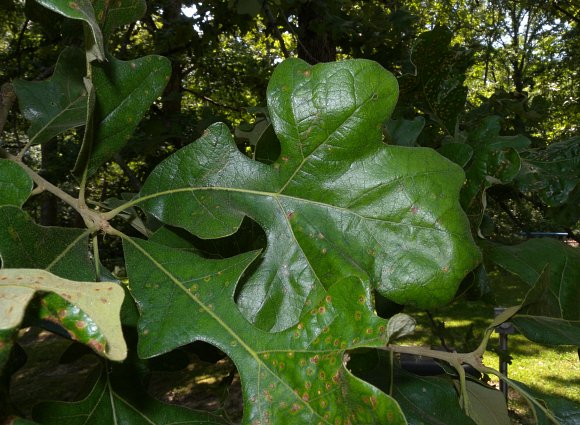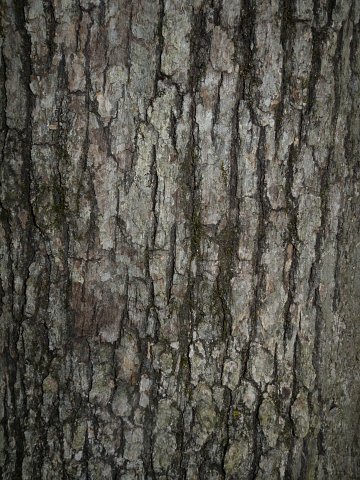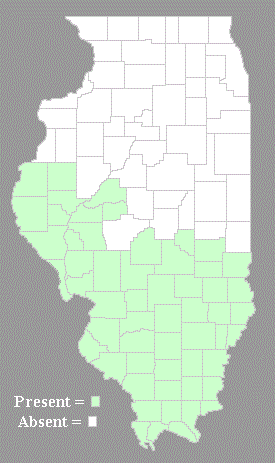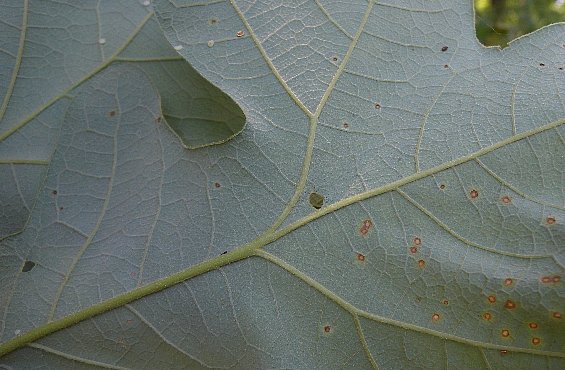
Like other Quercus spp. (oaks), Post Oak is monoecious, producing separate male (staminate) and female (pistillate) flowers on the same tree. Male flowers are produced in drooping yellowish catkins about 2-4" long. Each male flower has several stamens and a cup-shaped pubescent calyx with a jagged upper rim. Female flowers are produced in tiny clusters of 2-4 near the tips of twigs. Each female flower consists of an ovoid ovary that is embedded within a pubescent calyx with 3 rectangular lobes; there are 3 reddish styles. Both male and female flowers span about 1/8" (3 mm.) across. The blooming period occurs from mid- to late spring, lasting about 1-2 weeks. The flowers are cross-pollinated by the wind. Afterwards, fertile female flowers are replaced by acorns that become mature during the fall of the same year. These acorns are either solitary or they occur in pairs; they are either sessile or short-stalked (peduncles less than ¼" in length). At maturity, individual acorns are 12-18 mm. (½-¾") long and a little less across; their caps extend to about one-third of the length of the acorn. The caps have small appressed scales that are light gray or light tan and canescent, while the bodies of the acorns are light to medium brown. The meat of the acorns is white and slightly bitter. While young saplings produce thick taproots, older trees have root systems that are often widely spreading. Autumn coloration of the leaves is mostly brown, sometimes with yellowish or dark reddish tints.

Cultivation: The preference is full sun and mesic to dry conditions that are well-drained. The soil can contain loam, clay, sand, or stony material. The size of this tree is strongly influenced by moisture levels and fertility of the soil. Toleration of drought and heat are excellent, while toleration of waterlogged conditions is poor. While it is normally a small- to medium-sized tree in the wild, in cultivation Post Oak can become large-sized. The growth rate is relatively slow; individual trees can live 200-400 years. Acorns are produced on individual trees in about 25 years. The acorns do not require a winter dormancy in order to germinate; they should be planted in the ground after falling during the autumn. Various fungi can produce spots, blotches, blisters, and blights on the foliage, reducing its attractiveness. Post Oak is hardy to at least Zone 5 if a northern ecotype is selected.

Range & Habitat: Post Oak is native to west-central and southern Illinois, where it is occasional to locally common. Illinois lies along the northern range-limit of this tree. Habitats include upland woodlands, bluffs, upland savannas, wooded slopes, and rocky glades (including sandstone, limestone, and shale glades). Outside of Illinois, Post Oak is also found in dry sandy habitats. Sometimes this tree is cultivated in roadside and urban parks; it is also used for erosion control on exposed stony slopes. Common associates include other upland oaks (Quercus spp.), hickories (Carya spp.), and Eastern Red Cedar (Juniperus virginianus). Post Oak is found in average to high quality habitats where the soil is dry and infertile. It is not competitive with canopy trees that dominant moist fertile sites. Post Oak is able to resprout from its root system after most wildfires.
Faunal Associations: Many insects feed on the leaves, wood, plant juices, acorns, and other parts of Post Oak and other oak trees (Quercus spp.). They include larvae of metallic wood-boring beetles, larvae of long-horned beetles, larvae of bark beetles, leaf beetles, weevils, larvae of gall flies, plant bugs, stink bugs, aphids, leafhoppers, treehoppers, armored scales, mealybugs, larvae of gall wasps, larvae of sawflies, walkingsticks, larvae of Duskywing skippers (Erynnis spp.), larvae of Hairstreak butterflies (Satyrium spp.), and larvae of such moths as tiger moths, ribbed cocoon-making moths, case-bearer moths, Geometer moths, leaf blotch miner moths, lappet moths, slug caterpillar moths, midget moths, owlet moths, prominent moths, giant silk moths, clear-winged moths, trumpet leaf-miner moths, and Tortrix moths (see the Beetle Table, Aphid Table, Moth Table, and Miscellaneous Insect Table for more information). These insects attract several kinds of insectivorous birds to oaks, such as the Scarlet Tanager, Summer Tanager, Yellow-billed Cuckoo, Tufted Titmouse, Carolina Chickadee, Prothonotary Warbler, Northern Parula, Cerulean Warbler, Yellow-throated Warbler, Blue-gray Gnatcatcher, Acadian Flycatcher, Yellow-throated Vireo, and Red-eyed Vireo (Gabbe et al., 2002). The acorns of these trees are another source of food that attracts both birds and mammals. Ducks, crows, bluejays, blackbirds, woodpeckers, nuthatches, and parakeets feed on them (see Bird Table for more information). Such mammals as the Gray Fox, White-tailed Deer, Prairie Vole, Meadow Vole, White-footed Mouse, Virginia Opossum, Raccoon, Southern Flying Squirrel, Eastern Gray Squirrel, Fox Squirrel, American Red Squirrel, Eastern Chipmunk, Muskrat (minor), and American Black Bear also feed on the acorns of oaks. Elk and White-tailed Deer also browse on the twigs and foliage of these trees, while the Cottontail Rabbit gnaws on the bark of saplings and the American Beaver gnaws on the bark and wood of oak trees that grow near bodies of water (Martin et al., 1951/1961; Hamerstrom & Blake, 1939; Whitaker, 1966; Beeman & Pelton, 1980; Schneider et al., 2006). Northern Red Oak and other oaks provide protective cover to many kinds of wildlife. Such birds as the Red-shouldered Hawk, Cerulean Warbler, Hooded Warbler (saplings), Blue-gray Gnatcatcher, Eastern Wood-pewee, Yellow-throated Vireo, and Field Sparrow select oaks as nesting sites (Dijak et al., 1990; Newell & Rodewald, 2011; Bielefeldt & Rosenfeld, 2001; Best, 1978). Several species of bats also select oaks for daytime roost sites and locations of maternity colonies. This includes the Silver-haired Bat, Evening Bat, Big Brown Bat, Hoary Bat, Little Brown Bat, Tricolored Bat, Indiana Bat, and Northern Long-eared Bat (Perry et al., 2010; Perry & Thill, 2008; Swier, 2003; Baerwald et al., 2012; Veilleux et al., 2003; Carter, 2003).
Photographic Location: A roadside park in south-central Illinois.

Comments: Post Oak is an attractive tree that should be cultivated more often. It is relatively easy to identify because of the cruciform leaves that resemble a Maltese cross in shape. In addition, both the twigs and the leaf undersides are densely short-pubescent throughout, whereas many other species in the White Oak group have glabrous twigs and leaf undersides that are either glabrous or hairy only near the axils of major veins. In southern areas of its range (south of Illinois), Post Oak is a more variable tree and its leaves become more irregular in shape. Perhaps the most similar oak species in Illinois is Blackjack Oak (Quercus marilandica), which is a small upland tree with leaves that are roughly kite-shaped. As a member of the Red Oak group, however, Blackjack Oak has bristles at the tips of its leaf lobes and its acorns take 2 years to mature. The wood of Post Oak is highly regarded for its strength, hardness, durability, and moisture resistance; it is fine-grained and brown-colored. As a result, the wood of this tree is used to make furniture, rail ties, mining timbers, fence posts, wooden stairways, wooden rails, floors, siding, panels, veneer, pulp, and construction lumber. It is also burned as a fuel.